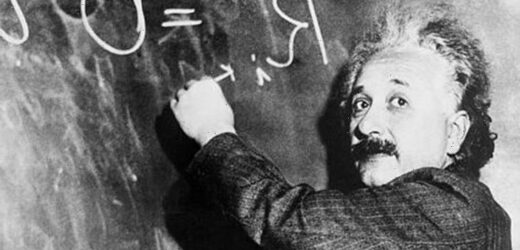Albert Einstein: Expert outlines 'astounding' doomsday theory
We use your sign-up to provide content in ways you’ve consented to and to improve our understanding of you. This may include adverts from us and 3rd parties based on our understanding. You can unsubscribe at any time. More info
Einstein’s famous E=mc2 equation was first published on November 21, 1905, and arose from his special relativity theory. It states that if you smash two sufficiently energetic photons, or light particles, into each other, you should be able to create matter in the form of an electron and its antimatter opposite, a positron. This has long proved difficult to observe, until now, according to findings published in the Journal Physical Review Letters.
Physicists from the Brookhaven National Laboratory in New York are claiming to have created matter from pure light for the very first time.
Using the laboratory’s Relativistic Heavy Ion Collider (RHIC), they have been able to produce measurements that closely match predictions for the strange transforming act.
They did so by taking an alternative approach to their experiment.
Instead of accelerating the photons directly, the researchers “accelerated heavy ions” in a big loop, before sending them past each other in a near collision.


As the ions are charged particles moving very close to the speed of light, they also carry an electromagnetic field with them, inside of which are a bunch of “virtual” photons.
These are particles that only pop into existence very briefly as disturbances in the fields that exist between real particles.
In their experiment, when the ions sped past one another they created a real electron positron pair that the scientists observed.
To check the virtual photons’ behaviour, the physicists detected and analysed the angles between more than 6,000 electron-positron pairs produced by their experiment.
READ MORE: UK to axe landline phones in digital shake-up sparking fears for elderly and vulnerable

When two real particles collide, the secondary products should be produced at different angles than if they were made by two virtual particles.
But in this experiment, the virtual particles’ secondary products bounced off at the same angles as secondary products from real particles.
This means the researchers could verify that the particles they were seeing were behaving as if they were made by a real interaction.
Daniel Brandenburg, a physicist at Brookhaven, said: “They are consistent with theory calculations for what would happen with real photons.”
In 1905, a year sometimes described as his annus mirabilis, Einstein published four groundbreaking papers.


These outlined the theory of the photoelectric effect, explained Brownian motion, introduced special relativity, and demonstrated mass-energy equivalence.
The mass-energy equivalence arose from special relativity as a paradox described by the French polymath Henri Poincaré.
Einstein was the first to propose the equivalence of mass and energy as a general principle and a consequence of the symmetries of space and time.
The famed German physicist passed away in 1955, aged 76, but his legacy lives on.
Source: Read Full Article


